FHWA Course on Bicycle and Pedestrian Transportation
Lesson 8
Tort Liability and Risk Management
8.1 Purpose
This lesson provides a working understanding of risk management principles,
tort liability, and techniques for monitoring and evaluating existing facilities
and programs. Key definitions are provided, along with information on litigation
trends, exposure evaluation methodologies, successful risk-reduction strategies,
and case study examples. Students will study examples that illustrate the
importance of considering human performance in planning and design and of
the role facilities play in creating predictable behavior. An understanding
of tort liability and risk management issues will alert the designer to the
need for evaluation and monitoring on an on-going basis and for creating built-in
feedback systems. More and more lawsuits are being settled against government
entities that adopt a "do nothing" posture. Identifying potential
risks, doing something and then evaluating the results as part of a systematic
program is proving to be a more defensible approach.
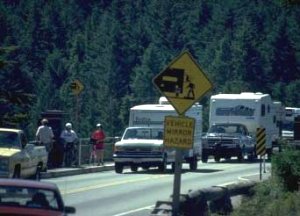
8.2 Introduction
To an increasing degree, issues of risk management and tort liability are
becoming major determinants of planning, engineering, and implementation programs
for bicyclists and pedestrians. Agency concerns about potential liability
can either lead to innovation and substantially improved facilities and programs
or they can lead to a "do nothing" approach. Ignoring risks does
not make them go away. Taking systematic steps to identify and evaluate risks
and to develop an effective risk management program are essential measures,
even if your agency cannot afford to remedy all problems immediately.
Without a well-conceived and implemented risk management program, the courts
become the de facto policy-makers.
Highway engineers, designers, and planners must consider the needs of the
pedestrian and bicyclist. Design of streets, bridges, surface conditions,
maintenance, and operations must be all viewed differently with the increasing
importance of bicycling and walking to people of all ages.

The needs of all users, young and old, should be incorporated
into highway and recreation facilities.
The very young, the old, and the disabled, in particular, must rely heavily
on walking and bicycling for everyday transportation and exercise. Highway
and recreational facility systems that fail to incorporate fully the needs
of all users increase the likelihood of potential court settlements in favor
of those who are excluded.
Since most highway professionals are not routinely trained to design for
the specific requirements of pedestrians and bicyclists, mistakes are common.
The result is increased risk, which is often not identified until crashes
occur. Training is especially important since many engineers and planners
do not bicycle or walk extensively under the conditions for which they design.
8.3 Liability – An Issue of Increasing Importance
Just how significant is the liability issue? Hasn't this whole thing possibly
been exaggerated? How much money is really involved? What do YOU think?
The total dollar amount of claims against U.S. highway agencies in a typical
year is between $50 and $60 billion.
- Planning, engineering, and public perception.
Most of us know that planning and highway professionals work hard to address
traffic problems, improve safety, save money, keep people and goods on the
move, and meet many other praiseworthy goals on behalf of the public. Does
the public we serve really understand the parameters within which we work?
Does it support our objectives? Does it know the limitations we face - the
schedules, budgets, and political pressures? Does it care?
Building and maintaining the public's confidence in
the work of government is a constant struggle. It is all too easy to blame
mishaps on "the bureaucrats" and to take them to court if the
opportunity arises. When someone travels a roadway or a trail on a regular
basis and a crash occurs, they generally look beyond themselves for someone
to blame. It is tempting to pin responsibility on the faceless public
agency most directly involved in design, maintenance, regulation, or operation
of the facility. People may not only file lawsuits, but also become publicly
critical of the agency and its programs. They become less likely to endorse
budget increases and bond issues. If asked to serve as jurors in tort
cases, they recall the negative experiences and perceptions and may filter
facts through this bias.
Implementing an aggressive and well-publicized risk
management program can help head off these problems. An effective first
line of defense is to build and maintain public confidence; to protect
budget allocations for needed public works projects; and to foster a
spirit of cooperation, not confrontation, between public and private
sector parties.
Today, the newspapers and electronic news media
frequently headline court settlements against public agencies that
have allegedly failed to use good judgment or carry out their professional
responsibility on behalf of public health, safety, and welfare. Some
settlements now soar as high as $10 to $14 million for a single injury.
Even minor lawsuits - which may be settled for as little as $5,000
- may require $10,000 to defend.
-
Governments can be sued for what they do.
The examples that follow illustrate conditions that can lead to pedestrian
and bicyclist injury. In these first two cases, the government was sued
for an injury to a pedestrian or bicyclist on a facility that was specifically
built to accommodate bicycling and walking.
Example: An attorney was riding a bicycle on a sidewalk that years earlier was marked as a bicycle path. He did not slow down
when approaching a residential driveway on a semi-blind corner. He
ran into a motorist exiting the driveway, hitting the car in the middle of the front-door panel.
Consequence: Bicyclist sues motorist and the condominium owners
for $750,000.
Lessons Learned:
The bicyclist will have a tough time proving that he was not guilty of contributory
negligence in this case. Since he hit the middle of the car, it can be argued
that he had plenty of discovery time had he been paying attention and riding
in a reasonable and prudent manner. The car was moving very slowly, stopping
to check for traffic and entering the street. The bicyclist's view of the
driveway was partially blocked by a perimeter wall around the condo complex.
Signing any sidewalk as a bicycle path increases the likelihood of tort
settlements even years later. By designating a sidewalk for bicycle use,
you send the message that it is "safe" to ride there. Sidewalk
facilities have built-in "booby traps" for the unsuspecting.
Sight-distance problems at intersections with streets,
driveways, and alleys are common on sidewalk facilities. Most local zoning
ordinances allow construction of rear and side yard walls to a height
of 6 feet on the rear and side property lines. Since sidewalks are often
located very close to rear or side property lines, especially in residential
areas, walls on these property lines seriously limit sidewalk views for
intersecting motorists.
Motorists expect pedestrians on sidewalks, not bicycles moving 10 times
as fast. Bicyclists, with the wind in their ears, on two-wheeled vehicles,
are not as sensitive to noise cues as pedestrians and not as maneuverable.
It takes them much longer to react and stop.
Since sidewalks have historically been regarded as "pedestrian zones,"
the pedestrian movement pattern of two-way traffic prevails. Bicyclists
using the sidewalk often think this applies to them too, and ride against
traffic. They don't see stop signs at cross-streets (located to be seen
by motorists on the other side of the street) and they are not part of
the normal scanning pattern for motorists.
A person waiting to turn right will scan to the left
for oncoming traffic, wait, and then move quickly to take advantage
of a gap. At first, he may take a quick look right to see if a pedestrian
is coming, but he seldom looks back. A fast-moving bicyclist can easily
escape detection and a crash can result. For these and other reasons,
sidewalks are not recommended for designation as bicycle facilities.
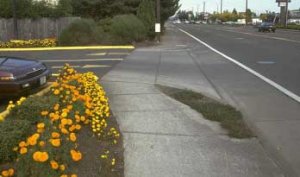
In order to see around obstructions near
the corner, motorists often pull out beyond them,
THEN stop to look for traffic. More often than not, this puts them
right across the sidewalk.
Example: A wheelchair user is traveling
along a sidewalk. The sidewalk is discontinuous, with an unpaved
stretch of about 150 feet. To get around this, the wheelchair
user moves into the street, going against traffic, gets stuck
in sand on the shoulder of the road and falls over. He can't get
up until a passer-by helps him, setting him upright and pushing
him through 150 feet of sand to the continuation of the paved
sidewalk. The wheelchair is damaged and the person is injured.
Consequence: Pedestrian sues City,
claiming negligence, and wins.
Lessons Learned: Consider ALL users.
Examine your community for these sorts of hazards and institute
an aggressive retrofit program. The City was said to have
led the wheelchair-bound person "into a trap." A
continuous paved surface should be provided or warning sign
posted well in advance.
- Governments can be sued for what they do not do.
"Do nothing" is not a viable option. In the two examples that
follow, injuries occurred because a government did not take action to correct
a potentially hazardous situation. More and more governments are being sued
for failing to recognize public needs and take actions to meet them.
Example: A pedestrian is walking along the sidewalk on a one-way
street, facing the flow of traffic approaching a signalized intersection.
Because the traffic signals are positioned to be seen by oncoming
(oneway) motor traffic, the pedestrian can see neither the
signal nor the "walk/don't walk" sign. He hesitates until
he thinks he has a green light and then steps out into traffic. After
getting partway across, he realizes that he has made a mistake, turns around suddenly, is hit and injured.
Consequence: The pedestrian sues the City and
wins. The City did not provide pedestrian-oriented traffic controls.
Lessons Learned: Consider ALL users.
Examine your community for these sorts of omissions and institute an
aggressive retrofit program.
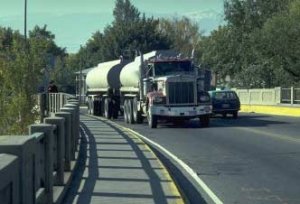
Example: On a bridge that provides
the main linkage to downtown, the surface is badly broken
up, the pavement is deteriorated on the decking, and seams have been slurried over, leaving dangerous ridges. This
bridge is known to be heavily used by bicycles and the
City has written to the State three times asking that the
bridge be repaired due to the potential hazard. Because
of these and other hazards, bicyclists cannot ride too
near the curb and crowd the motorists in narrow lanes.
The State has not responded, despite repeated requests
for action.
A semi-tractor trailer left his "Jake brake" on.
As he approached the bridge, he released his foot, activating
the brake, which caused a loud noise. A 23-year-old woman bicycling
across the bridge heard the noise behind her and moved over closer
to the curb. The trucker once again activated the brake, causing
another loud noise as he approached the bicyclist. The bicyclist
panicked, rode into the curb, fell, and was killed by the truck.
Consequence: The bicyclist's family and the truck driver's
insurance company both sued the State.
Lessons Learned: Because of the letter
written by the City and the length of time the condition had
been present, the State settled out of court. In addition to
the poor pavement conditions, it was found that the bridge sloped
slightly to the right and the State had, over time, let the
centerline of the roadway drift toward the right. The right-hand
lane was 13 feet wide, while the lefthand lane width was 17
feet. The bicyclist was forced to share a dangerously narrow
lane with both hazardous pavement conditions and heavy truck
traffic. The lesson here is to take action promptly in response
to identification of hazards, even if it means only the interim
measure of posting warning signs until the correction can be
made.
- Trends in tort settlements.
America is experiencing an increase in tort liability claims. The public
and its officials can and should demand fairness in settlements; however,
it is unlikely that we will see a dramatic reduction in charges and complaints.
Trends indicate just the opposite:
- More lawsuits are being filed.
- Legal action is becoming broader in its scope - suing
non-profits, families of those affected, as well as agencies and individuals.
- Government, well-insured corporations and professionals
continue to be favored targets due, in part, to their perceived "deep
pockets" and ability to pay.
- There is a tendency toward increased liability in
areas that once had some degree of immunity.
- There is a continuing rise in the size of claims.
Insurance companies often settle rather than defend. People
with a litigious bent are encouraged by the knowledge that insurance companies
often settle quickly rather than bear the time and cost of defending themselves
against relatively low-dollar claims. The courts are, in this way, taken
out of the process. The knowledge that even a frivolous lawsuit may net
someone $50,000 to $100,000 is a strong incentive to sue! It's a crazy world,
but risk management is here to stay. It is important that agencies and organizations
understand it and structure their actions accordingly.
The Impact of These Trends
The issue of risk management is becoming a major factor in decisions about
implementation of capital projects and programs. The high costs associated
with risk management have, in some cases, meant that things just don't get
built or programs don't get funded. Decision-makers are getting gun-shy. Ignoring
the problem, however, won't make it go away. As we stated earlier, governments
are just as often sued for what they don't do as for the actions they do take.
The best approach is to develop a strong, pro-active program to plan, design,
build, maintain, and operate a fully balanced transportation system that responds
to the needs of all potential users. The program must be based on a diligently
applied set of defensible standards and a public process that allows involvement
by all affected parties. An agency's ability to demonstrate that it is aware
of potential problems and is taking systematic steps to address them is very
important.
8.4 Some Basic Definitions
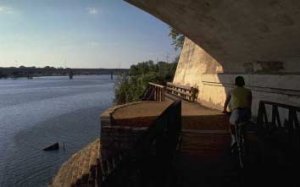
Transportation system programs should be based on
defensible standards.
To negotiate the legal minefields successfully, a working knowledge of some
basic terms is useful. What, really, is a tort? What is proximate cause? Negligence?
Sovereign immunity? Additional discussion of related concepts follows:
- Tort. Definition: A wrongful act, not including breach of contract or trust, that results in injury to another person's
property or the like and for which the injured party is entitled
to compensation. When an individual is harmed by another party without
criminal intent, he or she may be able file a tort claim. The tort claim must
be based on establishing that the party had a duty to perform relative to
the injured individual and that this duty was not performed with ordinary
care, in a reasonable and prudent manner. An injury resulting from a breach
of contract or trust does not fall within the definition of a tort.
Example and Discussion:
A 32-year-old mother of three was permanently disabled when she lost
control of her bicycle, went off a multi-use path into a drainage ditch,
and fell. Her back was severely injured when she struck a rock
on the far side of the ditch.
It was found that the bicyclist was not warned of the potential hazard
and thus was surprised by it. Once she went off the path, there was a trap
in the recovery area. The assumption that design for low-speed use only was
acceptable was found not to be valid. The City was responsible to design for
expected speeds and could have been found at fault in this case.
How could the path have been designed to minimize the chances of this type
of accident?
The path was originally designed as a pedestrian walkway and later designated
as a "bike path" without modifying it to bring it into conformance
with AASHTO or other accepted design standards for multi-use facilities.
When it was built, the path met current standards for pedestrian use. The
cost of rebuilding it to accommodate bicycles was thought to be excessive
by the City Council and signs were simply added to the existing path.
The rationale for this action was that the path was meant for recreational
use and that improving it to AASHTO standards would encourage high-speed bicycling
that would endanger pedestrians. It was thought that the narrow width and
tight turns would force bicyclists to ride slowly and use caution.
The woman injured in the crash approached the turn in the path at a reasonable
speed. Her view of the ditch was blocked by tall shrubs at the edge of the
path. The horizontal radius of curvature for the path was far below AASHTO
standards for a reasonable design speed. The path was designed for a maximum
speed of 11 mph, while AASHTO recommends a 20- mph design speed on level terrain,
with a 125-foot stopping sight distance.
The edge of the path dropped off directly into a culvert, with no shoulder
provided.
Swinging a little wide on the turn and having no available recovery area,
her tire dropped off the edge of the path into the culvert, and her bicycle
flipped, sending her flying to the far side of the drainage ditch.
If the substandard radius on the curve had not caused a loss of control, and
if the bicyclist had been able to see how tight the curve would become, and
if the culvert had not been in the curve alignment, then the crash might not
have occurred. The substandard design, then, is viewed as the proximate cause
of the injury. Proximate cause must be proven to establish negligence in court.
The City maintained that it was not designing for the high-speed bicyclist,
but for the novice recreational rider who would not go fast.
The courts found this position to have contributed to the cause of the accident.
This "contributory negligence" often results in rulings against
settlements favorable to the defense.
How could the path have been designed to minimize the chances of this type
of accident? Designers need to anticipate use by all types and ages of travelers
- motorists, pedestrians, bicyclists; young, old, disabled, or hale and hearty.
Only by understanding pedestrian and bicyclist behavior, perceptions, and
operations as well as most traffic engineers understand motorists can these
problems be avoided in the future.
- Negligence.
Definition: An act or omission within the scope of the
duties of an individual, agency, or organization that leads
to the harm of a person or of the public; the failure to use
reasonable care in one's actions.
To prove negligence, the plaintiff's attorney must prove each of these
conditions:
- The defendant has a duty to use reasonable care: Do the defendant's
duties include responsibility for some element of the accident (site,
vehicle, etc.)?
- The defendant did not responsibly carry out that duty (was negligent):
Did the defendant exercise ordinary care performing his or her duty in
a reasonable and prudent way?
- The defendant's failure to carry out that duty (negligence) was directly
responsible for the injury ("proximate cause").
- The plaintiff was not guilty of contributing to the cause of the accident
through contributory negligence.
- The plaintiff incurred damages resulting from the crash.
How is a judgment of negligence against government won?
It is not easy to prove negligence within the context of the four conditions
specified above. However, negligence must be proven if a judgment is to be
won. The example that follows is taken from an actual case where negligence
was alleged.
Example: The Florida Department of Transportation was charged
and tried in a civil court with negligence as a result of the bicyclist
falling on the bridge (Miller v. FDOT).
How Did the Injury Happen? The bicyclist's wheel fell into a bridge
counterweight slot. The rider was pitched forward, sustaining serious facial
injuries on the grating. The rider was a professional model and an experienced
bicyclist. She brought a tort charge against the State, which had to be defended.
How Would You Rrule? The bridge was built more than 30 years ago, before
bicycling became popular. There was no designated bicycle facility on the
bridge. The bicyclist was riding to the far left of the lane. Was this a legal
location for the bicyclist? Was this position within a narrow lane a logical
location? Did the bicyclist have sufficient discovery time to see and avoid
the slot? Could an adult with 8 years of bicycling experience, and who served
as a ride leader, and who had been over this route a dozen times previously,
have anticipated this danger? Considering your answers to these questions,
can the five conditions necessary for negligence be proven?
How Did the Courts Rule?
In this case, the court ruled against Florida DOT and the case was settled
for $250,000. It was argued that FDOT was negligent for the following reasons:
- FDOT had a duty to design, operate, and provide maintenance services
for the bridge. The open counterweight slot constituted a maintenance
condition. The government had a duty to maintain and operate a safe road
for all users. Florida DOT, furthermore, had a duty to warn the public
of an unsafe condition, and had failed to do so. It was argued that the
agency knew that bicyclists used this bridge, and that there had been
previous bicycling crashes on this grating and associated with this slot.
- The open slot had been previously reported as needing correction; but
the correction had not been made. It was, therefore, argued that FDOT
had not carried out its duty in a responsible manner. Even though the
correction had not been made, it could have warned bicyclists of a potential
hazard.
- The slot was the proximate cause of the crash. The bicycle wheel fell
through the slot and precipitated the crash.
- The bicyclist may have significantly contributed to the crash (been
guilty of contributory negligence): (a) she was riding in both an illegal
and illogical place on the roadway; (b) she was riding too fast for bridge
conditions; (c) she rode this route at least weekly and should have been
aware of the hazard; (d) she was riding directly behind another bicyclist
so she did not see the slot until it was too late to take evasive action;
and (e) she was an expert bicyclist with 8 years of experience who served
as a ride leader and officer in a bicycle club that used this route weekly;
as a leader, she had a responsibility to know and alert others to potential
hazardous conditions along the route.
- The bicyclist, a professional model, suffered severe facial damage.
The damage claims were found to be real and significant. A $250,000 settlement
was awarded.
- Ordinary Care.
Definition: Courts base settlements on the level of care
that a reasonably experienced and prudent professional or other
individual would have taken in the same or a similar event or
action. This level of care is referred to as "ordinary
care."
"Ordinary care" is distinguished legally from "extraordinary
care," which parties are not expected to meet. Standards for separating
"ordinary" from "extraordinary" are based on the expectation
that 85 percent of travelers operate in a responsible manner (the 85th Percentile
Rule).
Highway professionals are charged to design, operate, and maintain highways
for the reasonably prudent traveler.
Example:
In a private development, a bicyclist transporting a child crashed
into a second bicyclist, also transporting a child. One was approaching
a blind corner leading into an underpass from a lateral path
providing street access to a greenbelt path. Because of limited clearances
within the underpass, the bicyclist rode toward the middle of the underpass. He did not see the other bicyclist (approaching through the underpass
from the opposite direction) in time to avoid a crash.
The case was settled against the developer. The project designer did
not offer the same level of care for the bicyclist and pedestrian as was offered
to the motorist. The needs of all potential users must be given equal weight.
It was argued in court that motorists on the bridge were given the advantage
of full design, signing, and operations treatments based on AASHTO standards,
but the bicyclists in the underpass below were left to "fend for themselves"
in an abandonment of design principles.
- Sovereign Immunity. An agency that has full "sovereign immunity"
is not required to pay settlements. Partial immunity puts a cap on how much
can be awarded or limits exposure to certain areas, such as maintenance and
operations.
-
Limited Immunity. Today, most States and some counties have
limited immunity. Florida, as an example, has a maximum settlement amount
of $250,000 per incident. If the courts award a settlement in excess of
this amount, the plaintiff has to appeal before the legislature for the
difference.
Very few States still have full sovereign immunity, where a plaintiff
must request a waiver to win a government settlement. Some States allow
lawsuits, but specify that they must be filed within a short period of
time following the injury or limit the amount of the suit.
To date, few lawsuits have been won against the Federal Government, although
many suits are filed.
An example of this type of case is Coleman v. USA, where the National
Park Service is being sued for a bicycle crash that occurred when a bicyclist
crossed the centerline of a roadway to pass other riders during a large,
mass bicycle ride. In moving left to pass, he hit a concrete seam along
the center of the road at an oblique angle. His wheel caught the seam
and he went down. Although this case is still pending, the Park Service
is saddled with the expense of a defense.
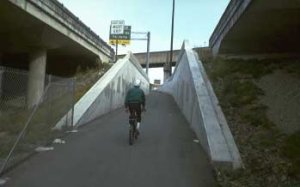
The same level of design, planning, and maintenance should be offered
for the bicyclist and pedestrian as is done for the motorist.
- What is Your Liability Limit? Many governments have partial
immunity, others have sovereign immunity. Consultants and corporations
have no immunity. Non-profit corporations are losing the immunity they
once had. Individuals seldom have immunity.
- Design decisions may have protection, but maintenance and operations do not. Certain actions have full or partial immunity
from legal action. As a general rule, governments still enjoy some immunity
in the area of design, although this, too, is eroding. There is little
immunity for actions related to operations or maintenance. Lawsuits relating
to signing, warnings, surface conditions, poor maintenance, and similar
factors are among the most difficult cases to defend.
Example:
A well-educated adult bicyclist, riding in the correct direction
on a bicycle lane, suddenly swerved left into the traffic lane, where
he was hit broadside by a car going 55 mph. He was thrown 120 feet,
landed on his head and, sustained severe brain injuries.
Who Was Sued?
In this case (Boyd v. Illinois), the lawsuit was filed against the bicycle
manufacturer and the construction company, since the State of Illinois refused
liability under legislative immunity.
Why Did the Bicyclist Lose Control?
The bicycle lanes are on a highway bordered by steep cliffs on one side and
a river on the other. On the river side of the highway, maintenance of the
lane is so poor that many bicyclists opt to ride against traffic, along the
cliffside lane, where the surface is in much better condition. They prefer
to take their chances with oncoming traffic rather than risk a fall from broken
pavement and the ever-present gravel, dirt, and debris along the river. The
cliffside bicycle lane is routed within the narrow zone between curb and motorway.
This zone traps a two- to three-foot- wide pile of debris and sediment, especially
after storms, leaving a perilously narrow strip for bicycle movements. The
bicyclist in the example lost control when a wrong-way cyclist suddenly challenged
him for his narrow portion of the lane.
Poor design (curbing and low-grade surfacing and construction quality) in
this case led to a poor maintenance condition on both sides of the highway.
The extremely poor maintenance on the river side led to an operations problem
when bicyclists routinely elected to ride against traffic to maintain their
stability rather than cope with the dangerously deteriorated pavement along
the river.
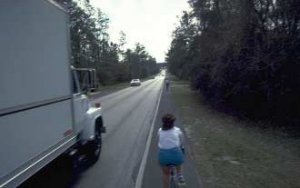
A systematic assessment of potential liability is the first step toward a proactive position.
8.5 Identifying Your Level of Exposure
- The General Process.
Given the trends discussed earlier, it makes sense to adopt a proactive position.
By developing a realistic assessment of the degree to which your agency may
be exposed to potential liability problems, you will have taken an important
first step toward developing a practical risk-reduction strategy. It is important
that this assessment be systematic, keyed to anticipate and counteract a wide
range of legal actions and that it involve all affected public and private
parties.
- Document the scope of your specified duties.
- For each type of duty, prepare a detailed list of the actions involved
in carrying it out.
- Do some homework. Research the crashes and lawsuits that have occurred
in your community.
- For each action, document or develop a reasonable standard or set of
criteria to be followed, taking into account their impact on all potential
users.
- Systematically evaluate your present programs and facilities according
to the criteria and standards defined for each action.
- Set priorities for action.
This process should provide a good idea of the strong and weak points of your
programs and facilities and an overall picture of your level of exposure.
By working thoughtfully through a systematic analysis of what it takes to
carry out your assigned duties and a realistic assessment of how well programs
and facilities measure up to accepted standards, you will probably learn a
great deal and establish a strong direction for subsequent development of
a practical risk-reduction strategy.
- Scottsdale, Arizona Case Study.
Let's look for a moment at a recent case study from the City of Scottsdale,
Arizona. Scottsdale has historically been a leader in the provision of bicycle
facilities. Since the early 1970's, an extensive and popular multi-use pathway
system has evolved-a north-south spine through the most populous part of the
city. The paths are used by many commuters, but were designed primarily as
recreational facilities. They are now 15 to 20 years old. Some portions were
built to standards that are now outdated or are more appropriate to pedestrians
than to bicyclists. Use of the paths has increased, along with potential conflicts
and the diversity of users. There have been crashes and lawsuits filed.
In 1989, Scottsdale voters approved $214,000 in bond money for bicycle path
improvements. This amount was not enough to bring the pathway system into
complete conformance with current standards, but it was an important first
step. The City commissioned a study to provide the City with a fully justified
basis for developing a risk-reducing improvement program within available
funding limitations.
Specifically, the study provided:
- Detailed documentation of existing conditions.
- Review of applicable standards and criteria.
- Analysis of existing conditions in the context of these standards.
- Priorities for implementation.
- A recommended action program.
The Scottsdale Bicycle Path Improvement Study focused on giving the
City a useful tool for reducing risk along its pathway system through a prioritized
set of recommended improvement projects.
- Is Ignorance REALLY Bliss?
The comment is sometimes heard that if all these potential hazards are
identified, then the agency's liability may increase since the agency can
be shown to have been aware of the hazards without correcting them. Are you
really less vulnerable if you don't know what the problems are?
In a word, the answer is "NO." Its not quite as simple as that,
but here is a summary:
-
What if you don't know about a potentially hazardous condition
and an injury occurs?
The success of your defense may, in part, depend on how discoverable
the condition was. The question is often asked, "Did the agency have
time to discover its error?" If a crash happened during the first
week this condition existed, there might be a strong defense since there
was not sufficient time to discover the error. If 2 years had gone by
before the crash, most courts would rule that there was plenty of time
for the agency to discover the condition and correct it.
If It's Broken - Fix It
Sometimes a condition is so patently unfair to the public that an
injured party will bring a suit where he or she would normally accept
most blame. For more than 15 years, bicyclists have been fighting governments
that have tried to keep them out of the roadway. If a pedestrian were
injured by a bicyclist on a sidewalk, one or both parties might file a
case against the government for forcing the bicyclist into a space that
does not provide reasonable and prudent sight distances, operational widths,
and, which now violates many laws, design standards, and accepted practices.
Example:
Difficult Maintenance Conditions (Walden v. Montana). A bicyclist
descending an interstate ramp into Great Falls, Montana, was slipstreaming two fellow bicyclists at high speed. At the pinch point, where
the guardrail and the lane narrow, the bicyclist came alongside
his friend. The friend moved out from the guardrail, forcing the
cyclist into the seam separating the travel lane from the ramp
lane. Hitting the lateral seam, the cyclist crashed, landing on
his head at more than 35 mph.
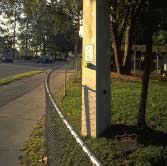
This pedestrian signal would not be accessible to
all users. How can a child reach this to cross the street
safely?
Was Montana responsible for maintaining a concrete/ asphalt joint to meet
the needs of the bicyclist on an interstate?
This case was tried and won for the defense, and upheld in the State supreme
court. The bicyclist contributed significantly to his own injury. The
highway department had a serious uncorrectable groundwater problem that
made it difficult to maintain a better joint. The joint met AASHTO standards
for preventing tire scuffing and vehicle deflection problems at such a
location. Signing the specific nature of the hazard for a bicyclist, who
would normally stay on the 10.0-foot shoulder, was not required to meet
the standard of ordinary care, which requires highway professionals to
design, operate, and maintain highways for the reasonably prudent traveler.
- What if you have been made aware of a potentially hazardous
condition and an injury occurs before you have taken steps to correct
the condition?
Agencies have a responsibility to fix problems, but the courts tend
to favor good will and intent to find solutions, even if some conditions
are too expensive to fix immediately.
Again, a great deal will depend on the length of time that has passed
between identifying the condition and the injury. If it can be shown that
a reasonably short period has elapsed and that the agency or other party
is taking positive steps toward correcting the condition, the defense
position will be improved.
If a city, for example, conducts a study to identify areas of potential
risk along a recreational trail system and does not have sufficient funds
to immediately make all corrections indicated by the study, all is not
lost!
If a crash occurs and the city can demonstrate that it has a well-documented
program of risk reduction and that it has taken some interim steps (such
as warning signs and markings) to alert trail users to potential risk
areas, its defense is strengthened. If it had not identified potential
risks and taken steps toward risk reduction, the city's defense would
have been substantially weakened.
Signing a hazardous condition has long been recognized as an important
interim treatment for many conditions. Failing to sign a known condition
is difficult to defend.
Signing and warning offers two types of benefits: (1) People are more
cautious, so the number of crashes and injuries are reduced; and (2) The
attempt to alert the public about a potentially hazardous condition generates
good will and makes it more difficult for a plaintiff's attorney to argue
that the plaintiff was surprised by the condition. Signing should make
use of international symbols, and follow standard signing and marking
practices found in the MUTCD (Manual on Uniform Traffic Control
Devices).
-
What if you have identified a potentially hazardous condition
and have taken steps to correct it?
What if you have trimmed shrubs that blocked sight distances, widened
a tight turn to meet AASHTO standards, and added rideable shoulders to
a path and STILL someone loses control and is injured? Assuming the agency
responsible for the path has carried out its duties using ordinary care
in a responsible way, it would be more difficult to prove negligence.
The burden of responsibility may well shift to the bicyclist or other
injured party whose contributory negligence may have led to the accident.
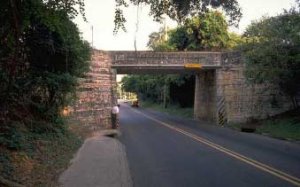
All facilities should end logically, with a reasonable warning,
and an alternative route, so that the user is not suddenly
"trapped."
8.6 Cases That Lead to Quick Settlements Against a Government
Now that we have discussed methods for evaluating risk, common design errors,
and general ways of strengthening your legal position, it may be useful to
look at some of the most common lawsuits - the ones government employees stay
up nights worrying about because they are usually settled quickly in favor
of the injured party. Some of the most important pitfalls to be avoided are:
- Open drainage grates in the travelway.
Lawyers refer to these as "waiting traps."
Much research has been devoted to analysis and design of bicycle-safe,
hydraulically efficient drainage grates. Temporary solutions are simple
and cost-effective. If the grate cannot be replaced immediately, it can
be rotated 90 degrees or temporary strips can be welded across it. It
can be marked as a potential hazard.
- Paths that end suddenly at "bad"
locations with no transition or escape route provided.
In court, you will hear that these sorts of paths "lead the customer
into a trap." All facilities should be ended logically, with a reasonable
warning ("Path Ends"), a transition to an alternate route and
some design precautions taken so the inattentive path user is not launched
off a cliff, slammed into a barricade around a blind corner, or otherwise
penalized too harshly.
- Inadequate curve radii.
Many designers are not aware that speed, not vehicle
design, is the sole determinate of the proper radius of curvature. A bicycle
and car going the same speed, say 20 mph, each need a 95-foot horizontal
radius for turning. If anything, the bicycle needs a slightly wider path
in a curve, since bicyclists lean into a turn, taking up slightly more
space. Design speeds of 20 mph on flat terrain and 30 mph for grades up
to 4 percent are recommended by AASHTO guidelines.
- Long-term, severe surface irregularities.
The longer that surface irregularities such as broken
pavement, potholes, raveled edges, bumps, seams, and gutter edge build-up
are left unattended, the greater the potential exposure and the more difficult
it becomes to convince a jury that you did not know the condition existed.
The jury will be convinced that the condition was discoverable, and you
may be found negligent.
- Poor sight distances
Like motorists, bicyclists need time to identify and
react to potential hazards, such as tight turns, obstructions in the travelway
and intersecting motor vehicles, pedestrians, and other bicyclists. At
least 6 seconds of discovery is needed to allow adequate reaction time,
mechanical set-up, and braking to a stop. At 20 mph (29.33 feet/second),
this is a distance of 176 feet. Walls and vegetation most often block
views, but sometimes, sight distances can also be limited by steep hills
(cresting sight distance) or curves on steep grades. Identify these problem
areas. Install warning signs and/or remove obstructions.
- Roadway design, planning, operation, and maintenance
that do not consider bicycle and pedestrian use.
It is no longer acceptable to plan, design, or build
roadways that do not fully accommodate use by bicyclists and pedestrians.
The bicycle is seeing increased use for transportation and the health
benefits of walking are receiving greater attention. There have now been
more than 20 years of experience with designing for bicycles in the Unite
States, with millions of dollars devoted to research and planning. With
every passing year, the courts become less and less sympathetic to agencies
that have not understood the message: bicyclists and pedestrians are here
to stay. Make sure your staff is knowledgeable about planning, design,
and other aspects of non-motorized travel. Be sure to take all modes into
account.
- Bridges and underpasses that are hazardous
to bicycles and pedestrians.
Like motorists, bicyclists need to cross bridges to
get to some destinations. Bridges are expensive to build and difficult
to retrofit for bicycling.
Example:
A bicyclist descended a steep grade at high speed in low-light
conditions, hit the depressed drainage area next to the sharp
guardrail, and lost control. The cyclist, drafting a friend at
17 mph, was contributing significantly to his risk.
Although settled out of court, FDOT had to consider the appearance
of the many protruding rails, posts, and other conditions that would
have been seen by a jury.
Risk Management Tip: Pay close attention
to bridges. Bridges have many surface conditions, maintenance problems,
and operations problems that must be dealt with. A facility of any
length is only as safe as its weakest link - often the bridge.
-
Poor maintenance of off-street facilities.
Many agencies have been successfully sued when people
slop on gravel, sand, grass clippings, standing water, deteriorating pavement,
and similar conditions. Bicycles are particularly sensitive to litter,
debris, and other materials. An aggressive maintenance program is essential
for all designated facilities. Develop a method for identifying and correcting
problems in a timely manner.
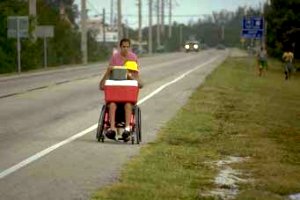
Courts have become less and less sympathetic
to agencies that do not consider the needs of bicyclists
and pedestrians.
Spot Maintenance and Improvement Programs:
Many communities have implemented a special
annual fund to attend to pedestrian and bicycling facilities spot
improvements. They have asked bicyclists and others to alert them
to any poor maintenance conditions. This fund and response system
allows the cities to respond to a hazardous condition within 48
hours of discovery.
8.7 References
Text and graphics for this section were taken from Drake and Burden, Pedestrian
and Bicyclists Safety and Accommodation Participation Workbook, NHI
Course No. 38061, FHWA-HI-96-028, 1996.
For more information on this topic, refer to:
American Association of State Highway and Transportation Officials, Guide
for the Development of Bicycle Facilities, 1991.
American Association of State Highway and Transportation Officials, A
Policy on Geometric Design and Highways and Streets, 1990 edition.
Betty Drake, Scottsdale Bicycle Path Improvement Study, Gruen
Associates and Baker Engineers, 1991.
Federal Highway Administration, Manual on Uniform Traffic Control
Devices (MUTCD), 1988 edition.










